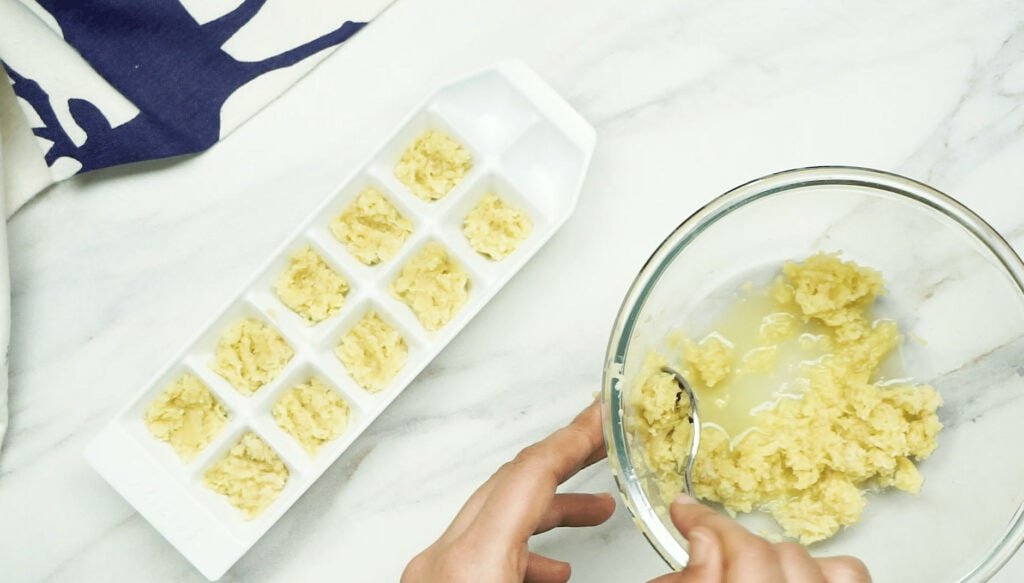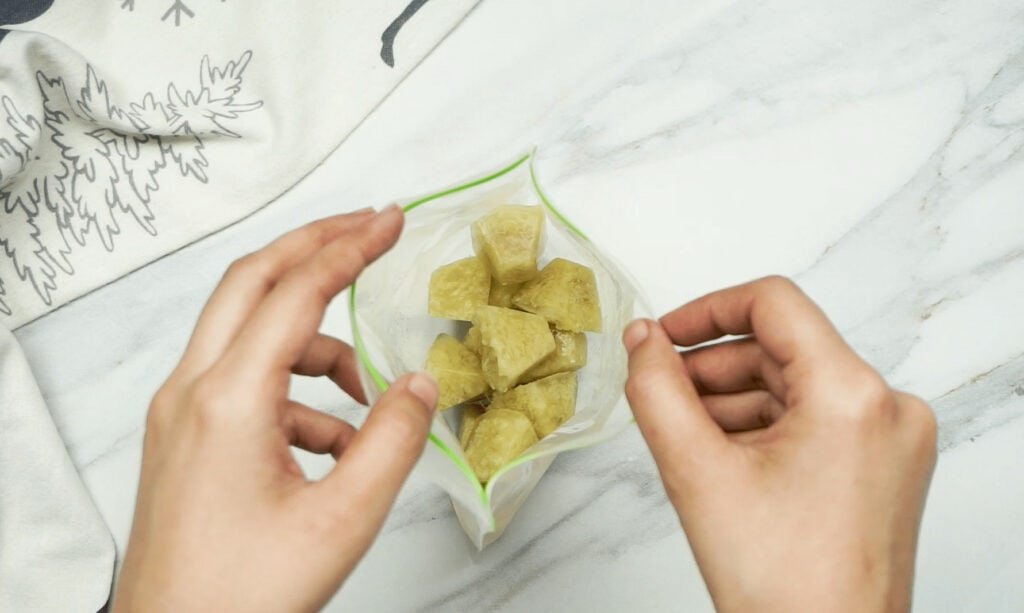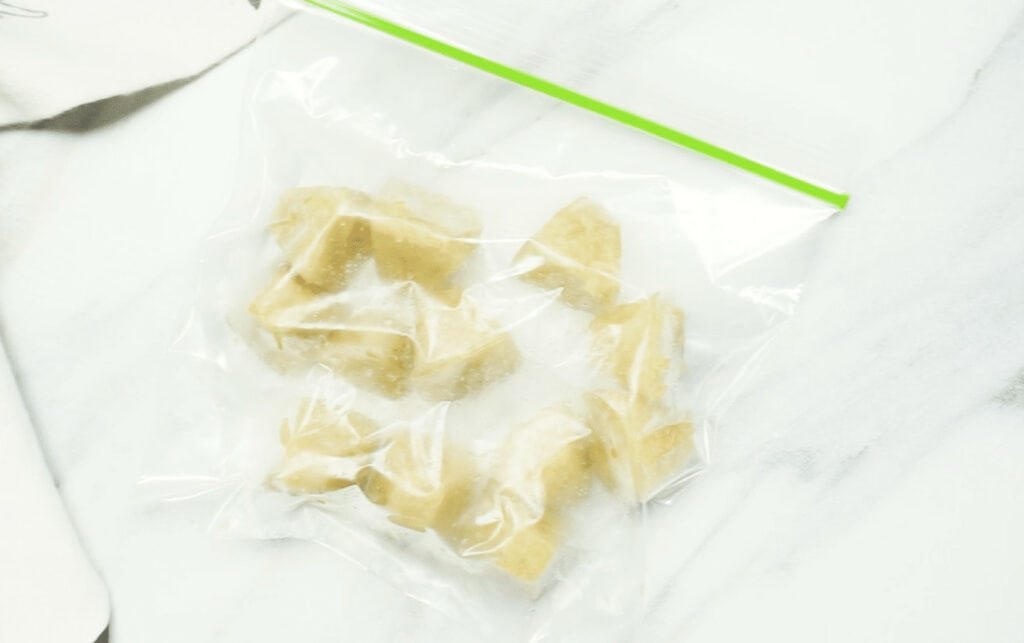Ginger is one of the most used spice ingredients from Japan to India. In many cuisines, it’s an essential ingredient. But, as you probably know, a little goes a long way. So what do you do with all that leftover ginger you might not need for a week or two?

Can You Freeze Ginger?
Yes, you can freeze ginger for up to 9 months. You can freeze ginger whole, grated into an ice cube tray, juiced or as a ready-to-use paste. You’ll often not even need to defrost your ginger to use it!
How to Freeze Ginger
Ginger is one of the most versatile spices out there. With this versatility, comes a whole range of ways you can go about freezing it. You can freeze it whole, in an ice cube tray, juiced and in a paste.
We’ve covered all four approaches below:
How to Freeze Ginger Whole
The easiest and most simplistic way to freeze ginger is to place it in a sealable container or a zip-lock bag and put it in the freezer. However, having a whole root in the freezer is unlikely to be practical:
- Peel
First, take your ginger root and peel it. The easiest way to do this is with a teaspoon and not a vegetable peeler. Scrap the spoon along the edges of the ginger to peel it without much wastage. - Cut Up
Cut the ginger into thumb-sized pieces. This is often what a recipe will call for so having them frozen as pieces make it easier to grab one piece at a time. This step is optional, however. - Bag Up
Once peeled, toss the ginger into a ziplock bag, seal it up tight to prevent freezer burn and place it in the freezer.
When you need your ginger, grate it straight from the freezer into your dish. As you’re grating it, the pieces will be so small that they’ll cook almost instantly without the need to thaw beforehand.
Freezing ginger whole is super quick, but we’d actually recommend freezing in thumb-sized pieces. This tends to be what recipes call for. That way, you can grab a thumb of ginger, and you have the portion ready to go.
How to Freeze Ginger in an Ice Cube Tray
If you want to have ginger ready-grated in the freezer, then this is the best way to freeze ginger. Before you freeze it, make sure you’ve got a lot of ginger grated in a bowl. You want the ginger in a fine paste so use a fine grater:
- Portion Into Ice Cubes
Grab ice cube trays, then place roughly one tablespoon (or three teaspoons, it’s the same quantity) into each ice cube slot, top up with water to cover the ginger and put it in the freezer.

- Bag Up
Once frozen, remove the tray and pop the cubes out. You can place these cubes into a resealable plastic bag or airtight container. Remove as much air as possible.

- Final Freeze
Return the bag to the freezer. When you want a hit of ginger in curry, stew or soup then grab a cube and toss it into your pot.

I love freezing cubes of most spices and herbs. You can try combining the ginger with garlic cloves, chillies and lemongrass for quick Thai-inspired flavour cubes that are perfect for a stir fry.
Ginger peel can be eaten so it’s not essential to peel it. However, if you would normally peel it to use it then we would advise doing the same before freezing it.
How to Freeze Different Forms of Ginger
Ginger doesn’t just come as a large root. Instead, it can be bought or turned into various forms. Here are some of the most common of these:
Juice and Shots
I find that freezing ginger shots and juice in an ice cube tray does the trick. Once frozen, I transfer the cubes to a freezer bag for later use. The benefit of this method is the convenience.
Whenever I need a ginger kick in my morning smoothie or a stir-fry, I just pop out a cube or two. One tip though – label your bag so you know exactly what’s inside.
Paste
When it comes to ginger paste, I spoon dollops of it onto a parchment paper-lined baking tray, freeze them, and then transfer the frozen dollops to a freezer bag.
These individual portions are so handy for adding a burst of ginger flavour to various dishes. One drawback might be that the texture of the paste can change slightly after freezing, but I’ve never found it to be an issue in cooking.
Grated
I tightly wrap about a tablespoon of grated ginger in plastic, making small parcels. Then, I put all the parcels in a freezer bag.
A small warning, though, is that ginger might lose a little of its potency over time, so use it up within a couple of months for the best flavour.
I would avoid freezing ready-made ginger tea but would instant freeze cubes of fresh ginger root or ginger slices that are ready to be used to brew ginger tea.
How Long Can You Freeze Ginger?
Frozen ginger portions stay well in the freezer for 9 months while maintaining good overall quality. This is a long time to keep ginger for future use!
If your freezer is stocked full with containers or bags of frozen vegetables, don’t forget to label your ginger, so, later on, you don’t find yourself wondering what that brown thing in the freezer is.
It’s important to remember to date the container or zip lock bag, so you don’t end up leaving it in there for too long, making it rot and go to waste.
Whole pieces of ginger that have not been cut will last for 2 months in the fridge. Once cut or peeled, it will only last for a few days before it loses texture and flavour.
How Do You Defrost Ginger?
Here’s some more good news about frozen ginger: You don’t necessarily have to thaw it!
Instead, when you need ginger for that fantastic meal you’re going to prepare, take a piece and grate it straight into the pan from the freezer.
If you need a lump of ginger in your dish, for example, if you were to use it in a stirfry, you would want to thaw it a little.
All you have to do is place the frozen portion in a bowl of cool water, and it will defrost in about 2 minutes. You could also leave it on the kitchen counter at room temperature for an hour or so.
You can also place the frozen piece of ginger in the microwave for roughly 15 seconds – that way, it will also be much easier to slice it. If it’s still not soft enough to slice, place the ginger piece back in the microwave for a few seconds more.
Can You Refreeze Ginger?
A lot of the flavour from ginger is in the moisture stored within the body of the ginger. When you thaw anything, you release some of this moisture, and with this moisture, you lose some of the flavours.
Frozen ginger can often be a little milder than fresh ginger.
If you were to refreeze it, that ginger flavour would only become milder. For this reason, it’s a good idea to hold back on refreezing ginger and try and defrost the amount you need when you need it.
Does Ginger Freeze Well?
Yes, ginger freezes really well. It’s a great way to avoid food waste.
Just like any fresh food, freezing ginger will decrease its quality to some extent. However, properly frozen ginger is nearly as good as fresh ginger, both flavour and nutrient-wise. Plus, you’ll never run out of ginger (isn’t that a big plus?)
Because fresh ginger has a very fibrous texture, one significant advantage of frozen ginger is that it is easier to grate than fresh ginger, even when unthawed.
Does Freezing Ginger Lose Nutrients?
No, freezing ginger will not cause it to lose nutrients, fortunately. Freezing will also not kill any nutrients. It is worth remembering that over time, as with any food, nutrients will naturally degrade but this will be a slow process.
Sources
We have verified the information on this page using the following resources:



Just wondering about refreezing ginger once it has been thawed. I’m trying to identify what upsets my stomach. Frozen ginger from Tesco seems to be an issue – it is thawed out by the time you get home, then you put it in the freezer and refreeze it. It says on the packet. IMPORTANT: If food has thawed, do not refreeze. What is the reason for that?
Have you tried cutting the frozen ginger from Tesco out of your diet for a few months to see if helps?
Thank you for all the information such easy to understand